| The Garden—January 2008 | |
| January 25, 2008 | |
 |
Look how bowed over my poor Coast Live Oaks are in this storm! I hope they end up growing straight after all this bending since they were planted. They are going to have to be tough to survive. Down below, the cardboard roll has blown down the bank a little. I hope it is lodged there until we can retrieve it, but I am not about to go down it this weather to find out. |
| January 23, 2008 | |
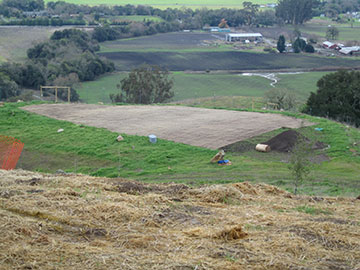 |
My assistant finished the cardboard—or at least as far as we can go until we move the dirt. I now need to lay out my rose beds and start planting. |
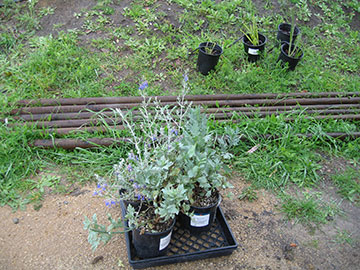 |
Here are some plants I bought for the place. There are some Matilija Poppies, which are native to the Channel Islands off Santa Barbara. They grow best in bad soil with no water (!) and have those wonderful, big, white flowers with the bright yellow centers which look like they are made out of crepe paper. They are very hard to start from seed because they don’t germinate unless they are heated up—as in going through a brush fire. Anyway, I will put them down by the pond. The other plants get quite large and have a pretty blue flower. I forgot to write the name down off the pot, and since I don’t currently grow large shrubs, I am not familiar with this plant. My whole scale of gardening is about to change—in every way. |
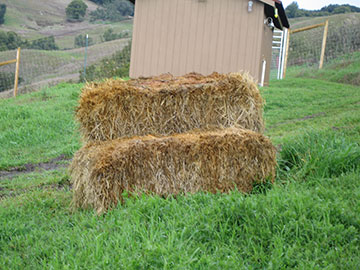 |
Here are the straw bales we brought up from below for mulch. We have them up on a pallet—although you can’t see it because of the grass—to protect them from rotting. Once it dries out a little, we will cardboard and jute the bank behind the cottage and barn and then strew this straw over the jute to cover it up. |
| January 16, 2008 | |
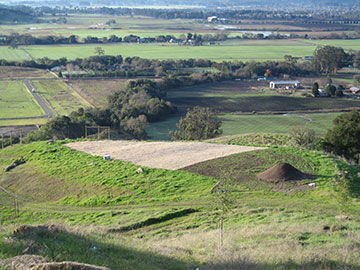 |
We had a little excitement with the cardboard this morning. Last week, my assistant finished the south end with the loose cardboard we had on site. I took a look at it first thing this morning and thought it looked great. Later on during the morning the wind came up very strongly. Part of the new cardboard started to loosen up and flip back. My assistant quickly came to the rescue with some extra stakes and pinned it down good. |
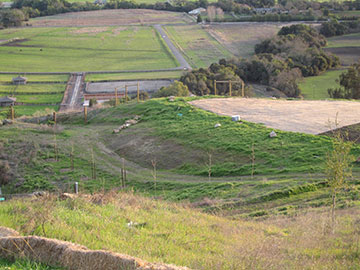 |
I like this shot because you can see the row of trees very well, even in this low resolution version. The sun was low enough to light up the trunks of my little allée. (I hope that is spelled correctly.) |
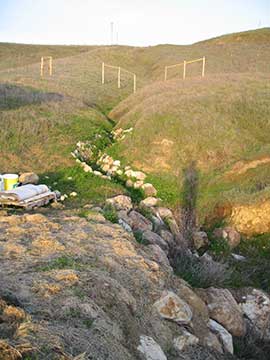 |
The new lining on our gully did very well in the rain, we are going to add to it with broken concrete, since we are currently out of rocks. |
| January 9, 2008 | |
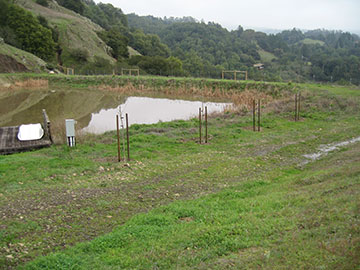 |
Here are some better pictures of my row of sycamores down by the pond. I sure hope I haven’t planted them to close together. We do plan to pollard them, so they won’t grow that tall. Look how much the recent rain has raised the level of the pond. We really had a downpour last week. Today I was in Napa and saw a sycamore that was both pollarded and pleached in an amazing way. First the tree was pollarded. That is the practice where a tree is allowed to grow to a certain height and then pruning it annually to keep it that height. In sycamores, this produces a tree with a straight trunk and perhaps 5 to 7 branches fanning out from the top of the trunk. |
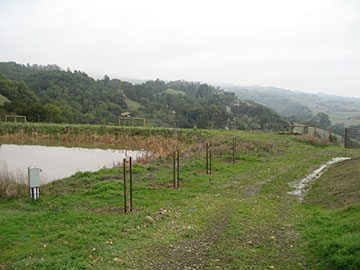 |
Pruned back every year, each of those branches develop a knobby knot at the end. In the spring, many suckers (straight branches with no side branches) sprout from these knots and leaf out, giving the tree a pleasing, even, round silhouette. Pleaching is a process where a tree branch is bent either toward another branch of the same tree or a branch on a different tree until it touches and then tied down. If done properly, the branches will grow together. On the sycamore I saw today, one sucker had been left on each knot and each had then been bent down to touch the next knot, so without any leaves the the tree had scallops on top. Amazing. I will have to look at it again when it leafs out. |
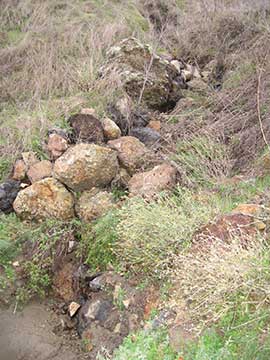 |
Here is the gully that drains into the pond. All that rock you see was placed there when the grading was done. Originally, at the bottom of the gully, there was a little silt pond dug and a pipe from it into the pond. This had a twofold purpose. First of all, the silt pond would keep dirt from washing into the pond and second, with the drain from it to the pond, we could have a road over it. The idea was that we would be able to drive all the way around the pond. This worked quite well the first year. But alas, I did not clean out the silt pond in the summer. (I did go down with a shovel on a very hot day, look at it and leave.) On New Year’s Day 2006, there was a horrific storm which dropped 10" of rain. Then it began to rain and rain and it rained until June. Sometime during that winter, too much water came down the gully and overwhelmed the pond, blowing it out and pushing dirt and mud into the pond. |
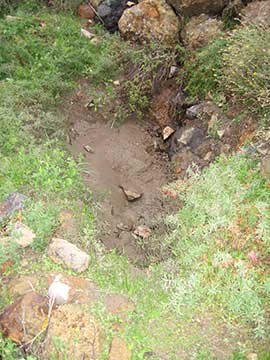 |
Earlier this year, I had my assistant dig out some of the silt pond. He did locate the end of the drain pipe. This recent storm washed out the pond and opened up the pipe pretty well, so now water is flowing through it instead of going over the road. Sometime in the future, we will have to get the dirt out of the pond somehow and rebuild the silt pond in earnest. This year, though, it is enough that the road isn’t washing out. |
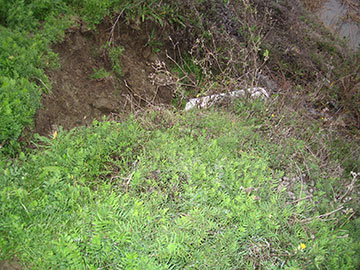 |
Here is the pipe going into the pond. Originally, you couldn’t see it from this angle at all, but when the water went across the road, it eroded this trench and exposed the pipe. |
| Back to top | |

